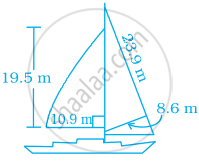Advertisements
Advertisements
प्रश्न
Find the missing value.
| Diagonal (d1) | Diagonal (d2) | Area |
| 12 mm | 180 sq.mm |
उत्तर
Given diagonal d2 = 12 mm; Area of the rhombus = 180 sq.m
`1/2` (d1 × d2) = 180
`1/2` (d1 × 12) = 180
d1 × 12 = 180 × 2
d1 = `(180 xx 2)/12`
d1 = 30 mm
Diagonal d1 = 30 mm
Tabulating the results we have
| Diagonal (d1) | Diagonal (d2) | Area |
| 30 mm | 12 mm | 180 sq.mm |
APPEARS IN
संबंधित प्रश्न
Lengths of the diagonals of a rhombus are 16.5 cm and 14.2 cm, find its area.
If length of a diagonal of a rhombus is 30 cm and its area is 240 sq cm, find its perimeter.
Each side of a rhombus is 18 cm. If the distance between two parallel sides is 12 cm, find its area.
The area of a rhombus is equal to the area of a triangle. If the base ∆ is 24 cm, its corresponding altitude is 16 cm and one of the diagonals of the rhombus is 19.2 cm. Find its other diagonal.
Find the area of a rhombus whose diagonals are of lengths 10 cm and 8.2 cm.
A sweet is in the shape of rhombus whose diagonals are given as 4 cm and 5 cm. The surface of the sweet should be covered by an aluminum foil. Find the cost of aluminum foil used for 400 such sweets at the rate of ₹ 7 per 100 sq.cm
The height of the rhombus whose area 96 sq.m and side 24 m is
The figure ABCD is a quadrilateral in which AB = CD and BC = AD. Its area is ______.

The area of a rectangular field is 48 m2 and one of its sides is 6 m. How long will a lady take to cross the field diagonally at the rate of 20 m/minute?
Most of the sailboats have two sails, the jib and the mainsail. Assume that the sails are triangles. Find the total area sail of the sailboats to the nearest tenth.

